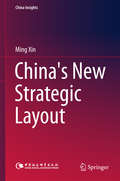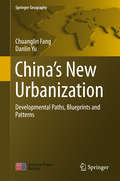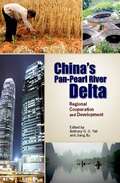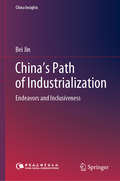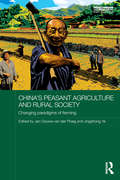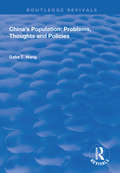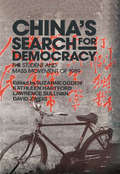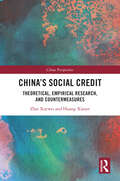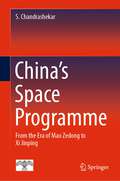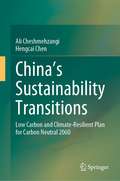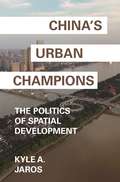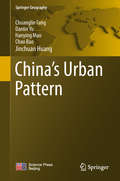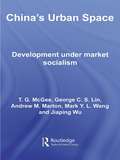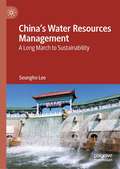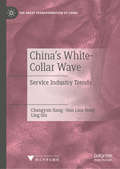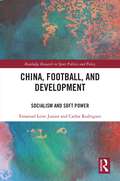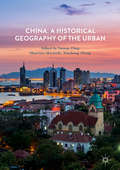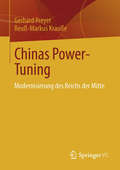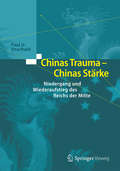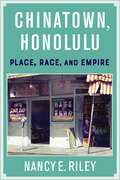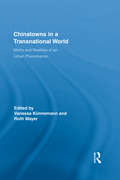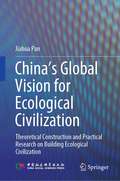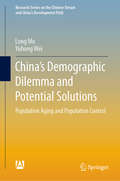- Table View
- List View
China's New Strategic Layout (China Insights)
by Ming XinThis book, based on the Chinese dream and its basic principles, global significance, path of implementation and practical requirements, systemically explains China's Four-Pronged Comprehensive Strategy. The Four-Pronged Comprehensive Strategy is the strategic concept of the Communist Party of contemporary China. In the coming five and even the fifty years, the economic and social development of the Chinese society will be centering on it. Comprehensively constructing a moderately prosperous society is the strategic goal, comprehensively deepening reform and advancing the law-based governance of China are the engine and guarantee in realizing the strategic goal, while strengthening the Party Self-discipline represents the strategic measures to build up a firm core leadership. The Four-Pronged Comprehensive Strategy shows not only the CPC's view of China but also the view of world.
China's New Urbanization: Developmental Paths, Blueprints and Patterns (Springer Geography)
by Chuanglin Fang Danlin YuThis book answers the call for NewUrbanization, and proposesa "5+9+6" nationalspatial layout plan for the urbanizationof the 770 major cities in China. This macro pattern is based on a fewmajor metropolises at the center, and other cities supporting and benefitting from thesemetropolises to form a pyramid-like urban hierarchical system. The book also presents a comprehensiveregionalization plan for China's New Urbanization and strategic approaches to improving the quality of thisNew Urbanization. Currently, China is aggressively promoting a so-called New Urbanization, which has been regarded as one of the primaryways to build a moderately prosperous society, to address critical issuesrelated to agriculture,rural regions and farmers, to expand domestic demand and promote industrial innovation, and to realize the China Dream. From a systematic perspective and using recently released urban data, theauthors analyze the current status of New Urbanization in China and also investigatethe various potential problems and obstacles to its concrete implementation. Based on the analysesand investigations, the authors propose strategic directions, paths and basicprinciples for China's New Urbanization. In addition, they clearly identify the three differentmodes of New Urbanization, namely, the general mode, differentiated mode, and gradual mode. Today, many scholars argue that China's urban regions areexperiencing a highly unsustainable mode of development. Chinese cities areheavily burdened by theso-called "urban diseases,"which are characterized e. g. by congested traffic, polluted water and air, and a lack of open and green spaces. Traditionalurbanization, which primarily focuseson economic development, mustbe fundamentally reformed. New Urbanization, which focuses on integrated economic development,social integration and space/environmental sustainability, or simply put, on the quality ofurbanization, has been called for to provide a potential "cure" for these urban diseases. Due to the vastness of China'spopulation and its rapidly growing economic, political and cultural relationshipswith the rest of the world,the book demonstrates thatthe success of this New Urbanization is critical not only to the future of urban China,but also the future of urbanization worldwide. Thebook offers a valuable referencework for all researchers, graduate student and policy makers interestedin China's urban development.
China's Path of Industrialization: Endeavors and Inclusiveness (China Insights)
by Bei JinThis book reviews China’s industrialization from the perspective of inclusiveness, and discusses the challenges arising from its industrialization process and how the Chinese people view and seek to overcome these challenges. By examining China’s industrialization in the context of the global economy, it reveals how China should be further integrated into and contribute to the great endeavor of worldwide industrialization and human development in the new era of economic globalization, allowing it to become a responsible stakeholder through its national rejuvenation for the benefit of the entire world.
China's Peasant Agriculture and Rural Society: Changing paradigms of farming (Routledge Contemporary China Series)
by Jan Douwe van der Ploeg Jingzhong YeChina's agriculture and rural society has undergone rapid changes in recent years. Many poorer farmers and younger people have moved to cities, and yet China has an immense challenge to feed a growing and more affluent population. This book provides a ‘bottom-up view’ of China’s agriculture, showing how the many millions of Chinese peasants make a living. It presents a vivid description of the mechanisms used by rural households to defend and sustain their livelihoods, increase their agricultural production and improve the quality of their lives. The authors examine the newly emerging trajectories of entrepreneurial and capitalist farming and assess whether such alternatives will be able to meet the enormous social, economic and environmental challenges that China faces. The book also explores the paradigm that has underpinned the organisation and development of China’s agriculture from ancient times to the present day. This shows the importance of balancing in the Chinese model as compared to the one-sided imposition of continual modernization in the western model. It is argued that such balancing is at the core of the current Sannong policy, referring to the three ruralities of food sovereignty, wellbeing for peasant households and an attractive countryside.
China's Population: Problems, Thoughts and Policies (Routledge Revivals)
by Gabe T. WangPublished in 1999, this text sets out to provide an historical, present and futuristic understanding of China's enormous population problems. It sets out to provide a fundamental understanding of China through an understanding of its population problems and the efforts to control them. With the world's largest population, China has a dynamic economy and is emerging as a world power. This book aims to provide a comprehensive discussion on issues relating to China's population in English, based on historical and macro-level analysis of Chinese society.
China's Search for Democracy: The Students and Mass Movement of 1989
by David Zweig Nancy Sullivan Suzanne Ogden Kathleen HartfordWithin a framework of analysis and background by the four editors, this book presents a view from the grassroots of the 1989 student and mass movement in China and its tragic consequences. Here are the core eyewitness and participant accounts expressed through wall posters, students speeches, movement declarations, handbills, and other documents. In their introductions to the material, the editors address the political economy of the democracy movement, the evolving concept of democracy during the movement, the movement's contribution to China becoming a civil society, and the changing view of the Chinese Communist Party by students, intellectuals, workers and others, as the crisis unfolded.
China's Social Credit: Theoretical, Empirical Research, and Countermeasures (China Perspectives)
by Zhai Xuewei Huang XiaoyeThis book analyzes credit crisis issues in China from the aspect of individuals, enterprises, and government through investigations of six Chinese urban and rural areas.After China’s Reform and Opening Up in the 1970s, a slew of new problems involving integrity, trust, and credit appeared with the establishment of a market economy and the creation of new business opportunities. To track these phenomena down to their very origins and to explore the theoretical principles underlying them through a truly holistic sociology, this book highlights a native Chinese perspective when dissecting and analyzing the characteristics of their origins, mechanisms, and manifestations. The book will be of great interest to students and scholars of economic sociology, Chinese studies and those who are interested in the sociology of credibility in general.
China's Space Programme: From the Era of Mao Zedong to Xi Jinping
by S. ChandrashekarThis book comprehensively covers the history and current developments of space programme of China. It presents the complete story of China’s space programme from its origins through to present day activities on the International Space Station. This monograph further discusses the role of China’s space strategy in its emergence as a major power on the world stage. The book also presents the context of China’s space program within the larger narrative of international space development. The book binds together the diverse political, military, economic and technology aspects into a coherent understanding and explains their role in the establishment and growth of Chinese space programme. Given the contents, this book will be a valuable source of information for students, researchers, and historians in the area of space studies.
China's Sustainability Transitions: Low Carbon and Climate-Resilient Plan for Carbon Neutral 2060
by Ali Cheshmehzangi Hengcai ChenThis book considers the impact of global climate change, advocating to promote sustainable development from the perspective of low carbon and climate resilience, by reducing carbon emissions in different aspects of urban and regional development. As the world's largest emitter of carbon dioxide, China is continuously exploring a sustainable path to achieve the momentous goal of 2060 carbon neutrality. In addition, this book reviews and summarizes China's green development and predicts the transformation of China's carbon emission and energy structure before and after the peak of carbon emission in 2030. It examines the role of governance in decarbonization efforts, focusing on decision making processes, policies and regulations, as well as the significance of regions, cities, and communities. This book highlights typical methods of implementing and achieving low carbon development in light of China's practical situation, which helps to resolve some of the problems that may arise in achieving the carbon neutral goal. Therefore, this book is suitable for the reference of scholars in low-carbon environment science, sustainable urban development, and other related fields. It also provides inspiration for China's medium and long-term sustainable development plans in the future.
China's Urban Champions: The Politics of Spatial Development (Princeton Studies in Contemporary China #4)
by Kyle A. JarosThe rise of major metropolises across China since the 1990s has been a double-edged sword: although big cities function as economic powerhouses, concentrated urban growth can worsen regional inequalities, governance challenges, and social tensions. Wary of these dangers, China’s national leaders have tried to forestall top-heavy urbanization. However, urban and regional development policies at the subnational level have not always followed suit. China’s Urban Champions explores the development paths of different provinces and asks why policymakers in many cases favor big cities in a way that reinforces spatial inequalities rather than reducing them.Kyle Jaros combines in-depth case studies of Hunan, Jiangxi, Shaanxi, and Jiangsu provinces with quantitative analysis to shed light on the political drivers of uneven development. Drawing on numerous Chinese-language written sources, including government documents and media reports, as well as a wealth of field interviews with officials, policy experts, urban planners, academics, and businesspeople, Jaros shows how provincial development strategies are shaped by both the horizontal relations of competition among different provinces and the vertical relations among different tiers of government. Metropolitan-oriented development strategies advance when lagging economic performance leads provincial leaders to fixate on boosting regional competitiveness, and when provincial governments have the political strength to impose their policy priorities over the objections of other actors.Rethinking the politics of spatial policy in an era of booming growth, China’s Urban Champions highlights the key role of provincial units in determining the nation’s metropolitan and regional development trajectory.
China's Urban Pattern (Springer Geography)
by Chuanglin Fang Danlin Yu Hanying Mao Chao Bao Jinchuan HuangThe book embarks on the tasks to systematically analyze the macro background of the spatial patterns of China’s urban development, the theoretical foundations and framework, and its changing trajectory. From a quantitative perspective, we attempt to evaluate the rationale behind the spatial patterns of China’s urban development and systematically simulate the various scenarios. From the simulation results, we propose the optimizing goals, priorities, models, and strategies for the spatial patterns of China’s urban development. The work in this book attempts to provide constructive suggestions and potential strategies to support the effort to optimize the spatial patterns of China’s urban development. It would be a valuable reference for planning departments, development and reform committees, and science and technology administrative departments at various governmental levels. It could also be a valuable addition to graduate students of urban planning, urban development, urban geography and relevant disciplines.
China's Urban Space: Development under market socialism (Routledge Studies on China in Transition #Vol. 29)
by Mark Wang George C.S. Lin Terry McGee Andrew Marton Jiaping WuChina’s urban growth is unparalleled in the history of global urbanization, and will undoubtedly create huge challenges to China as it modernizes its society. Adopting an interdisciplinary approach, this book presents an overview of the radical transformation of China’s urban space since the 1970s, arguing that to study the Chinese urbanization process one must recognize the distinctive political economy of China. After a long period as a planned socialist economy, China’s rapid entry into the global economy has raised suggestions that modernization in China will inevitably result in urban patterns and features like those of cities in developed market economies. This book argues that this is unlikely in the short term, because processes of urban transition in China must be interpreted through the lens of a unique and unprecedented juxtaposition of socialism and the market economy, which is leading to distinctive patterns of Chinese urbanization. Richly illustrated with maps, diagrams and in-depth case studies, this book will be an invaluable resource to students and scholars of urban economics and policy, geography, and the development of China.
China's Water Resources Management: A Long March to Sustainability
by Seungho LeeThis book investigates water resources management and policy in China over the last two decades with a core focus on the role of water for socioeconomic development and sustainability. Recent policies, such as the Three Red Lines and the Water Ten Plan are evaluated for sustainable water supply, use and quality control. The book appraises solutions through demand management, water rights and pollution trading, virtual water and water footprint. Supply management is discussed taking examples from the Three Gorges Dam and the South North Water Transfer Project. The water market is investigated uncovering the active engagement of the private sector and includes discussions on how transboundary rivers demonstrate China’s engagement with its riparian countries for benefit sharing. This book will be an invaluable reference for researchers in the field as well as practitioners and students who have an interest in water and development in China.
China's White-Collar Wave: Service Industry Trends (The Great Transformation of China)
by Changyun Jiang Qun Lian Hong Ling QiuThis book explores the move from manufacturing towards service industry jobs in China's economic development during the 12th Five-Year Plan period. The service industry now makes up the highest proportion of the GDP and employs the largest number of people in China. In the next Five-Year Plan period, it is necessary to actively push forward the strategic transformation by placing emphasis on the service industry to press ahead with system and mechanism reforms and policy innovations and cultivate diverse, sustainable and continuous forces for driving its growth. Efforts are made to upgrade the service industry to better achieve economic and social development in an innovative, coordinated, green, open, and shared way. This book will be of interest to scholars researching China's future.
China, Football, and Development: Socialism and Soft Power (Routledge Research in Sport Politics and Policy)
by Carlos Rodrigues Emanuel Leite JuniorThis book uses football as a lens through which to examine China’s economic development, its political economy, and its political thought. Focusing on the Chinese Football Development Plan, the book opens up new perspectives on the concepts of hegemony, soft power, socialism with Chinese characteristics, and China’s rise to the position of geopolitical superpower. Presenting a critical Marxist analysis of ‘soft power’, and drawing on Gramsci’s conceptualisation of hegemony, the book argues that football can be seen as a resource for seduction and persuasion, and therefore as an instrument to be used in the ‘hegemonic clash’. Reflecting on the idea of soft power in relation to imperialism and ideology, and standing in contrast to prevailing Western orthodox analyses of Chinese development, this book shows how the ‘Chinese Football Dream’ is a significant component of the ‘Chinese Dream’ of ‘rejuvenation of the nation’, and shows how football can help us to better understand the role of the state as an inducer of development and creative destruction. This is fascinating reading for anybody with an interest in sport policy, public policy, sport and society, football, development studies, political economy, or political thought.
China: A Historical Geography of the Urban
by Maurizio Marinelli Yannan Ding Xiaohong ZhangThis book offers a unique contribution to the burgeoning field of Chinese historical geography. Urban transformation in China constitutes both a domestic revolution and a world-historical event. Through the exploration of nine urban sites of momentous change, over an extended period of time, this book connects the past with the present, and provides much-needed literature on city growth and how they became complex laboratories of prosperity. The first part of this book puts Chinese urban changes into historical perspective, and probes the relationship between nation and city, focusing on Shanghai, Beijing and Changchun. Part two deals with the relationship between history and modernity, concentrating on Tunxi, a traditional trade center of tea, New Villages in Shanghai and street names in Taipei and Shanghai. Part three showcases the complexities of urban regeneration vis-#65533;-vis heritage preservation in cities such as Datong, Tianjin and Qingdao. This book offers an innovative interdisciplinary and international perspective, which will be of interest to students and scholars of Chinese urban studies, as well Chinese politics and society.
Chinas Power-Tuning: Modernisierung des Reichs der Mitte
by Gerhard Preyer Reuß-Markus KraußeDer vorliegende Band stellt einen neuen Zugang für das Verständnis der Modernisierung Chinas seit den 1990er Jahren vor. Die Umstellung von der Plan- zur Marktwirtschaft verstehen wir nur dann angemessen, wenn wir die sozial-strukturellen Veränderungen der chinesischen Gesellschaft erfassen. Mit diesem Buch erhalten China-Interessierte aus Wissenschaft, Wirtschaft und Politik einen Einblick in die Modernisierung Chinas, ihrer besonderen Eigenart und ihrer zu erwartenden zukünftigen Veränderungen. Die LeserInnen bekommen ein Verständnis des Hintergrunds der chinesischen Gesellschaft, das es ihnen erlaubt, gesellschaftliche Zusammenhänge der chinesischen Modernisierung zu erkennen. Die Untersuchung enthält darüber hinaus einen Leitfaden für Entscheider, der ihnen für die Gestaltung ihrer Kommunikation mit Chinesen hilfreich ist.
Chinas Trauma – Chinas Stärke
by Paul U. UnschuldPaul U. Unschuld bietet eine kulturhistorisch begründete Analyse der politischen Geschichte Chinas der vergangenen zwei Jahrhunderte. Ein erster Teil beschreibt die verschiedenen Traumata, die dem Land im 19. und frühen 20. Jahrhundert durch ausländische Interventionen zugefügt wurden. In der zweiten Hälfte werden die Ursachen offen gelegt, die zu einem historisch einmaligen Vorgang geführt haben: dem Wiederaufstieg eines Staates, der von Staaten einer fremden, militärisch-technisch überlegenen Kultur besiegt und an den Rand des Abgrunds gebracht wurde. In seinem Geleitwort erläutert Ulrich Sendler die Bedeutung des Wissens um diese Hintergründe für ein Verständnis der Motivation und Erfolgsaussichten der Modernisierungsstrategien Chinas in einer zunehmend digitalisierten Welt.
Chinatown, Europe: An Exploration of Overseas Chinese Identity in the 1990s (Chinese Worlds)
by Flemming ChristiansenIs Chinatown a ghetto, an area of exotic sensations or a business venture? What makes a European Chinese, Chinese?The histories of Chinese communities in Europe are diverse, spanning (amongst others) Teochiu speaking migrants from French Indochina to France, and Hakka and Cantonese speaking migrants from Hong Kong to Britain. This book explores how such a wide range of people tends to be - indiscriminately - regarded as 'Chinese'.Christiansen explains Chinese communities in Europe in terms of the interaction between the migrants, the European 'host' society and the Chinese 'home' where the migrants claim their origin. He sees these interactions as addressing several issues: citizenship, political culture, labour market exclusion, generational shifts and the influences of colonialism and communism, all of which create opportunities for fashioning a new ethnic identity. Chinatown, Europe examines how many sub-groups among the Chinese in Europe have developed in recent years and discusses many institutions that shape and contribute ethnic meaning to Chinese communities in Europe.Chinese identity is not a mere practical utility or a shallow business emblem. For many, China remains a unifying force and yet local and national bonds in each European state are of equal importance in giving shape to Chinese communities. Based on in-depth interviews with overseas Chinese in many European cities, Chinatown, Europe provides a complex yet enthralling investigation into many Chinese communities in Europe.
Chinatown, Honolulu: Place, Race, and Empire
by Nancy E. RileyThe Chinese experience in Hawai‘i has long been told as a story of inclusion and success. During the Cold War, the United States touted the Chinese community in Hawai‘i as an example of racial harmony and American opportunity, claiming that all ethnic groups had the possibility to attain middle-class lives. Today, Honolulu’s Chinatown is not only a destination for tourism and consumption but also a celebration of Chinese accomplishments, memorializing past discrimination and present prominence within a framework of multiculturalism. This narrative, however, conceals many other histories and processes that played crucial roles in shaping Chinatown.This book offers a critical account of the history of Chinese in Hawai‘i from the mid-nineteenth century to the present in this context of U.S. empire, settler colonialism, and racialization. Nancy E. Riley foregrounds elements that are often left out of narratives of Chinese history in Hawai‘i, particularly the place of Native Hawaiians, geopolitics and U.S. empire building, and the ongoing construction of race and whiteness. Tracing how Chinatown became a site of historical remembrance, she argues that it is also used to reinforce the ideology of neoliberal multiculturalism, which upholds racial hierarchy by lauding certain ethnic groups while excluding others. An insightful and in-depth analysis of the story of Honolulu’s Chinatown, this book offers new perspectives on the making of the racial landscape of Hawai‘i and the United States more broadly.
Chinatowns in a Transnational World: Myths and Realities of an Urban Phenomenon
by Ruth Mayer Vanessa KünnemannThis book explores the history, the reality, and the complex fantasy of American and European Chinatowns and traces the patterns of transnational travel and traffic between China, South East Asia, Europe, and the United States which informed the development of these urban sites. Despite obvious structural or architectural similarities and overlaps, Chinatowns differ markedly depending on their location. European versions of Chinatowns can certainly not be considered mere replications of the American model. Paying close attention to regional specificities and overarching similarities, Chinatowns thus discloses the important European backdrop to a phenomenon commonly associated with North America. It starts from the assumption that the historical and modern Chinatown needs to be seen as complicatedly involved in a web of cultural memory, public and private narratives, ideologies, and political imperatives. Most of the contributors to this volume have multidisciplinary and multilingual backgrounds and are familiar with several different instances of the Chinese diasporic experience. With its triangular approach to the developments between China and the urban Chinese diasporas of North America and Europe, Chinatowns reveals connections and interlinkages which have not been addressed before.
China‘s Global Vision for Ecological Civilization: Theoretical Construction and Practical Research on Building Ecological Civilization
by Jiahua PanThis book addresses the core tenets, logic, methodology and practice of Xi Jinping’s thoughts on ecological civilization. It traces the theoretical origins of his ideas and comprehensively discusses their theoretical characteristics and historical status, while also demonstrating that they represent a self-contained theoretical system and discourse system. In addition, the book offers guidelines on putting his thoughts into practice in connection with the new era of socialist ecological civilization in China, implementing the 2030 sustainable development agenda action plan and contributing to global ecological security.
China’s Civil War
by Diana LaryChina's Civil War is the first book of its kind to offer a social history in English of the Civil War in 1945–9 that brought the Chinese Communist Party to power. Integrating history and memory, it surveys a period of intense upheaval and chaos to show how the Communist Party and its armies succeeded in overthrowing the Nationalist government to bring political and social revolution to China. Drawing from a collection of biographies, memoirs, illustrations and oral histories, Diana Lary gives a voice to those who experienced the war first-hand, exemplifying the direct effects of warfare - the separations and divisions, the exiles and losses, and the social upheaval that resulted from the conflict. Lary explores the long-term impact on Chinese societies on the Mainland, Taiwan and Hong Kong, which have all diverged far from pre-war Chinese society.
China’s Demographic Dilemma and Potential Solutions: Population Aging and Population Control (Research Series on the Chinese Dream and China’s Development Path)
by Long Mo Yuhong WeiThis book is a quantitative assessment of the challenges China faces as it tries to achieve the twin goals of mitigating the effects of population aging while containing the overall size of the population. After a close examination of the impact of China’s fertility policies on the country’s population structure and size, the author presents empirical evidence for the effectiveness of finely calibrated easing of the country’s decades-long birth control policies for both of these objectives. This research uses an innovative quantitative indicator—the Aging and Economic Coordination Index (AECI)—to measure the macroeconomic pressure population aging places on the country. This is the first time the AECI has been systematically applied to gauge the magnitude and the trends of that pressure for the 1980–2050 period, and to provide the basis for policy suggestions about what might be done to ease that pressure.
